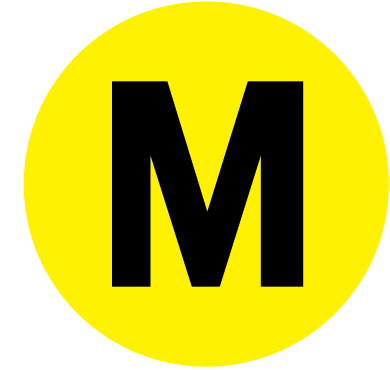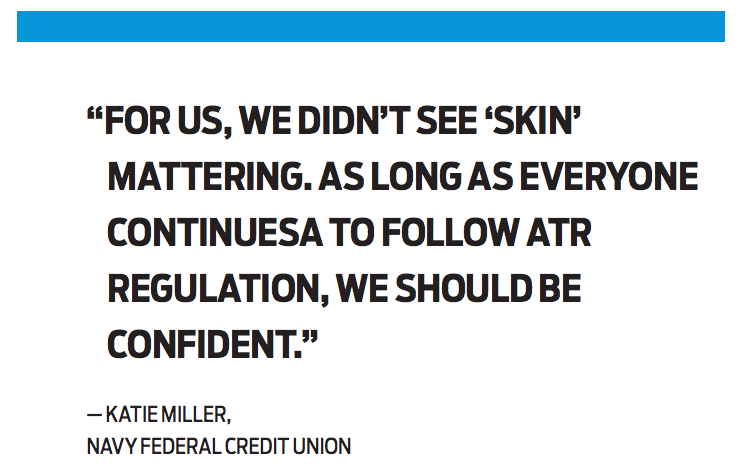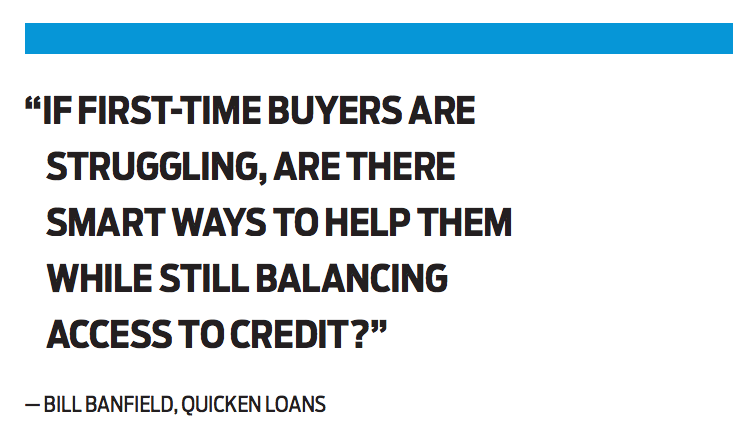 aking homeownership more affordable isn’t crazy,” Mat Ishbia, CEO of United Wholesale Mortgage, maintains.
aking homeownership more affordable isn’t crazy,” Mat Ishbia, CEO of United Wholesale Mortgage, maintains.
Ishbia sits at the helm of the No. 1 wholesale lender in America, which was also one of the first lenders to step up and offer 3% and even 1% down mortgage programs.
“People shouldn’t be worried about the 3% down program,” he continued. “The FHA, USDA and VA have been doing it for years, and with the right guidelines and criteria in place these are great for borrowers. Whatever is best for borrowers and prudent lending standards is what all lenders and originators should be looking to offer.”
His opinion stands in stark contrast to some of the bad press these loans are getting. Comment sections on articles about the low down payment programs are flooded with opinions such as, “Borrowers need to have some skin in the game if you want to limit defaults,” and, “When there’s no skin to lose, borrowers walk away and let taxpayers figure it out.”
For many observers, “skin in the game” is synonymous with a large down payment that limits lender or investor risk. However, skin in the game can be defined much more broadly, since financial investment is only one factor that mitigates risk.
Take VA loans for example. These are backed by the U.S. Department of Veteran Affairs and allow borrowers to put no money down and have no mortgage insurance.
Those eligible include service members on active duty, who could get orders to ship out the day after closing. They have absolutely no skin in the game when it comes to money and yet this group was one of the first to have this low down product available to them.
Katie Miller is vice president of mortgage lending for Navy Federal Credit Union, which opened its doors in 1933 and has more than 5 million members,  most of whom are service members.
most of whom are service members.
Since she has been with the credit union, Miller said VA has been more than 50% of its volume, and their no-down loans performed better through the recession than industry prime.
Of course, VA loans are different than the 3% down GSE loans, because they don’t require a down payment or mortgage insurance. The biggest difference is that they are backed by the government.
Miller explained that she could see could see how banks would be hesitant about offering low down payment options, but for Navy Federal, their willingness comes down to their loyal membership. “With a credit union, we know our members. We have a history with the vast majority of our members. We see all of their interactions. At a bank, anyone could come in,” she said.
“I think people look at the 3%, as ‘that’s the skin in the game.’ For us, we didn’t see skin mattering. As long as everyone continues to follow ability-to-repay regulation, we should be confident,” she said. “That’s just responsible lending, ATR. We aren’t trying to put people into these loans if they can’t afford these payments.”
“Ability-to-Repay is something Navy Federal has always done, no matter the economic climate,” Miller said.
“We are able to offer the types of products we do because our members are loyal, and respect the fact we are both looking out for their best interests, and the interests of our membership as well. Every member is a shareholder at credit unions and we are responsible custodians of their money.”
Now there are two new 3% down products on the table: Freddie Mac’s Home Possible Advantage and Fannie Mae’s HomeReady, making people question whether or not there’s enough skin in the game.
Even though both the GSEs’ low down mortgage programs have been in the industry for nearly two years, they are still in their infancy, and those in and out of the industry are not fully familiar with the programs yet.
Introducing the 3% down
At the tail end of 2014, both government-sponsored enterprises announced new 97% loan-to-value mortgage programs.
Fannie Mae and Freddie Mac released the 97% LTV ratio option to expand access to credit for qualified first-time homebuyers who may not have the resources for a larger down payment.
Ever since the financial crisis, a tight credit box has been the norm. Mortgage credit availability hit a low in 2009 and has remained relatively level since 2013, posting very marginal increases each quarter, according to the Mortgage Bankers Association’s Mortgage Credit Availability Index, which analyzes data from Ellie Mae.
It was the same year that both of these products came out that Mel Watt, the director of the Federal Housing Finance Agency, urged the opening of the mortgage credit box to less-than-optimal borrowers in an interview with HousingWire.
At the time of the announcement in 2014, Andrew Bon Salle, Fannie Mae executive vice president for single-family underwriting, pricing and capital markets, said, “This option alone will not solve all the challenges around access to credit. Our new 97% LTV offering is simply one way we are working to remove barriers for creditworthy borrowers to get a mortgage. We are confident that these loans can be good business for lenders, safe and sound for Fannie Mae and an affordable, responsible option for qualified borrowers.”
Fannie Mae’s low down program was originally released as MyCommunityMortgage, but later replaced in August 2015 with HomeReady mortgage. The rebrand came with changes, and one of the most significant was that first-time and repeat homebuyers can purchase a home using HomeReady with a down payment of as little as 3%.
Fannie Mae changed its program again in July 2016, opening the door to allow the occupant borrower on a HomeReady loan to own other residential properties, along with quite a few other changes.
The enterprise also broadened the options for the online education course borrowers were required to take to prepare them for the home-buying process and provide post-purchase support for sustainable homeownership.
Meanwhile, Fannie’s brother Freddie was busy working on its own low down product, Home Possible Advantage. Since the 97% LTV product was a lot newer for Freddie, it waited to implement the product until March, in order to have more time to do some foundation work.
When the news first came out, Dave Lowman, executive vice president of single-family business at Freddie Mac, said, “Home Possible Advantage gives qualified borrowers with limited down-payment savings a responsible path to homeownership and lenders a new tool for reaching eligible working families ready to own a home of their own. Home Possible Advantage is Freddie Mac’s newest effort to foster a strong and stable mortgage market.”
#div-oas-ad-article1, #div-oas-ad-article2, #div-oas-ad-article3 {display: none;} To do, or not to do, the 3% down program
These new programs were about as well received in the market as a child offered broccoli for dinner. And while there was a lot of apprehension at first, just as broccoli is genuinely healthy for kids and they’ll be appreciative when they’re older, the industry has come to embrace the 3% down.
Around the time the new products came out, Eric Klopfer, MGIC vice president of corporate strategy, wrote an article titled “Three reasons why restoring 3% down loans makes sense,” noting that at first, many at MGIC were a bit surprised regarding the somewhat pessimistic reaction or apprehension to the news.
Comments on the news article included statements such as, “There’s no skin in the game,” “It’s starting again,” and “What could possibly go wrong?”
One commenter went so far as to say, “Oh boy. Isn’t it this the type of lending that got us into the mortgage crisis to begin with? I can already see it now, inflated appraisals so first-time buyers can achieve the 3% equity and ta da, we are right back into 100% plus loan-to-value mortgages, and people will just walk away when the value drops below the debt on the first downswing in the real estate market.”
“What perhaps makes those reactions even more confusing is the simple fact that similar products have long been available through government programs such as the FHA,” Klopfer said.
The Federal Housing Administration allows borrowers to put as little as 3.5% down with a credit score of 580 or higher. For borrowers with credit scores from 500 to 579, they have to put down at least 10%. However, it’s important to note that many banks have overlays on FHA loans, and a lower credit score means a higher interest rate.
There were some lenders who jumped on the new opportunity early on, including United Wholesale Mortgage.
Most of the initial support for the new products came from nonbank and smaller lenders like AMCAP Mortgage, which is based in Houston, whose CEO and director, Garrett Clayton, told HousingWire at the time that this is definitely a product it would offer.
“Our philosophy is that we are a sell organization, and if that is a product that the agencies are going to put out there, we will have to offer that to our loan originator base,” Clayton said. “From the mortgage side, why would anyone say this is not a positive?”
3% down versus other low down products
These new low down products didn’t come out of left field. As Klopfer noted, the FHA has had its hand in this game for awhile.
At United Wholesale Mortgage, Ishbia said that they offer six programs in the 3.5% down or less area: Fannie Mae, Freddie Mac, FHA, VA, USDA, and now its conventional 1% down.
To help put into perspective how much volume these other programs get, the most recent MBA mortgage application report at the time of publication showed the Federal Housing Administration’s share of total applications at 9.7% of mortgage volume, the Veteran Affairs’ share of total applications sat at 12.5% of mortgage volume and the United States Department of Agriculture’s total applications sat at 0.6% of volume.
This is compared to mid-September 2015, when the FHA’s share of total applications sat at 14.2%, the Veteran’s Administration share of total  applications sat at 10.7%, and the Department of Agriculture share of total applications sat at 0.8%.
applications sat at 10.7%, and the Department of Agriculture share of total applications sat at 0.8%.
And in comparison to September 2014, the FHA’s share of total applications sat at 15.7%, the Veteran’s Administration share of total applications sat at 14.3%, and the Department of Agriculture share of total applications sat at 1%.
Right now, it’s hard to judge the success of the GSE programs since both enterprises choose not to disclose that information.
However, in an interview with HousingWire after the government-sponsored enterprise posted its second-quarter earnings, Donald Layton, Freddie Mac’s CEO, did shed some light on the current performance of its Home Possible Advantage product.
For starters, Freddie Mac recorded the highest level of first-time buyers its had in 10 years, stating that 42% of non-refinance purchase buys were to fund loans to first-time homebuyers.
He also noted that the 97% LTV product has significantly more attractive characteristics for first-time homebuyers.
However, despite both factors, he said that the numbers are not large enough to be driving an increase yet, as both programs have only been in the market for roughly two years.
Freddie partners with Quicken Loans and Bank of America
As the rest of the industry was fixated on the 3% down, Quicken Loans was quietly working away at a new product that takes the low down payment concept even further: a 1% down payment.
Quicken Loans began offering a 1% down mortgage toward the end of 2015, nearly a year before the idea started gaining traction with other lenders.
While Freddie Mac and Quicken Loans originally announced at the MBA Annual conference in San Diego in 2015 that they were partnering to pilot a series of initiatives aimed at helping provide more Americans the opportunity to achieve homeownership, it wasn’t clear at the time that this included the 1% down.
Quicken Loans didn’t open up about the product until late June 2016, when it finally went on the record explaining everything in an interview with HousingWire.
Bill Banfield, Quicken Loans’ vice president of capital markets, explained in an interview that the 1% down loan program isn’t quite as shocking as it appears.
Turns out, the product falls under Freddie Mac’s Home Possible Advantage program. In order to make 1% down possible, Quicken gives borrowers who qualify a 2% grant, thus making a total of 3% down.
But the 1% down program isn’t offered to everyone, Banfield said. There are several rules as to who is eligible.
First, Quicken’s 1% down loans are only available for purchase mortgages; no refinances are permitted. Second, the program can only be used on a single-family home or condo, not a second home, investment property or co-op.
Additionally, borrowers must have a FICO score of 680 or above, must earn less than the median income for their county, and must carry a debt-to-income ratio of 45% or less.
And according to Banfield, the terms of this loan are advantageous over a loan backed by the FHA, for example.
“The truth of FHA is that its max loan-to-value ratio is 96.5%,” Banfield explains. “But most buyers roll in their upfront mortgage insurance premium of 1.75%, leaving them with 98.25% LTV.”
“We want to try to help people and do it in a smart way,” Banfield said. “For us, it was really a question of if you want to provide access to credit, how do you do it responsibly? How can you help people? If first-time buyers are struggling, are there smart ways to help them while still balancing access to credit?”
Meanwhile, Freddie also partnered with Bank of America, but with very different guidelines and stipulations, announcing an affordable mortgage program in February 2016 that offers consumers the option of putting as little as 3% down and requires no mortgage insurance.
Bank of America also announced the partnership was with Self-Help Ventures Fund, an affiliate of the Center for Responsible Lending, for its new “Affordable Loan Solution” mortgage, a conforming loan that provides low- and moderate-income homebuyers access to a responsible lending product with counseling at affordable entry prices.
When the product was announced, D. Steve Boland, consumer lending executive at Bank of America, said, “There is a need in today’s marketplace for more responsible mortgage products that enable creditworthy homebuyers, who meet certain income limits and other requirements, to become homeowners at an affordable entry point with comprehensive counseling.”
In these partnerships with Quicken Loans and Bank of America, the industry can gauge the success of the growing low down products, since the exact success of Freddie’s Home Possible Advantage program isn’t easily quantifiable.
And they’re two barometers that Freddie’s Layton touched on. During his earnings call, Layton noted that Freddie’s partnerships with Quicken Loans and Bank of America are meeting, if not exceeding, expectations. The statement doesn’t provide facts and numbers, but it is useful qualitative data.
#div-oas-ad-article1, #div-oas-ad-article2, #div-oas-ad-article3 {display: none;} Big banks adapt
Now more than a year into the program, the mega banks, just as Bank of America did, are not only jumping on board the low down idea, but they are coming up with their own versions.
In May 2016, Wells Fargo announced a program that offers as little as 3% down for fixed-rate mortgages called yourFirst Mortgage.
This program is a partnership with credit experts such as Fannie Mae and Self-Help, “to develop an easy-to-understand affordable loan option that gives homebuyers the best offering in the market,” said Brad Blackwell, executive vice president with Wells Fargo Home Lending.
The product is still new and growing, but Wells Fargo did share on its second quarter 2016 earnings call that the early reaction to this program has been positive, with over $1 billion of applications in the first 30 days.
Not too long after, JPMorgan Chase also started a 3% down mortgage. However, the lending standards are more stringent than the similar programs of the other mega banks.
To take part in the Chase program, customers must have a FICO score of 680 or higher and at least one customer must be a first-time homebuyer.
“We are constantly innovating by exploring new products and enhancing existing ones to meet the needs of our customers across the credit spectrum,” Steve Hemperly, Chase’s head of mortgage originations, said in a statement at the time.
The 1% down keeps growing
Quicken Loans was only the start of the 1% down. In July, United Wholesale Mortgage announced it would also start offering a 1% down payment program.
Similar to Quicken Loans, the wholesale lender said it would provide eligible homebuyers with a 2% lender-paid down payment, which would give consumers 3% equity at closing, fulfilling Freddie’s Home Possible Advantage 3% down requirement.
 “The 1% down program we’re introducing is a new alternative to the 3% down programs that already exist,” Ishbia said. “It’s a conventional loan that is designed for people with a strong credit payment history who want to keep as much money in their wallet as possible when buying a home.”
“The 1% down program we’re introducing is a new alternative to the 3% down programs that already exist,” Ishbia said. “It’s a conventional loan that is designed for people with a strong credit payment history who want to keep as much money in their wallet as possible when buying a home.”
“By introducing this conventional 1% down program to the wholesale space, we’re equipping mortgage brokers with a distinct competitive advantage in the market and a new way to help borrowers realize homeownership,” Ishbia said.
Shortly before UWM launched its 1% down, Ishbia explained in an interview that these new low down mortgages are the future of lending, especially with Millennials.
It’s a common misconception for borrowers to think they need to put 20% down a mortgage, which often becomes the biggest roadblock to homeownership.
Instead of the typical 20% down, Ishbia said, “I would put 3% or 5% down and keep that extra 15% in your pocket for when you buy furniture, when your car breaks down or when something happens to your new house. Basically, putting 20% down is like digging a hole in the backyard and burying the money.”
“If you have 20% to put on a house, you probably waited too long to buy a house,” he joked.
Guaranteed Rate and Fifth Third Mortgage also revealed similar programs of their own in July, both in partnerships with Freddie Mac.
While there is no end date on UWM’s 1% down, Fifth Third said that it plans to keep the product at least through the end of the year and potentially through 2017. Similarly, Guaranteed Rate said there is no time limit on the availability of its 1% down program, noting that it will continue to monitor the program as it gains ground.
And this should only be the beginning to more lenders jumping in.
Ishbia explained that since homeownership is great for borrowers and the overall economy, and this program helps make that possible for more people, others will start offering the product.
Freddie Mac’s stance
“We’ve all emerged from the housing crisis like coming up from a storm cellar after a tornado hit. We had to assess what to address first and we’re making our way back toward normality,” Danny Gardner, Freddie Mac vice president of affordable lending and access to credit, said.
“In this vein, it is a matter of dealing with the repercussions of the crisis, learning from its fallout and addressing new regulation on the way to regaining focus on the business of lending.”
The industry has to acknowledge that it’s a brand new day, Gardner said, “It’s different right now. There are many new guardrails in place.”
Gardner explained that the lenders offering the 1% down are working with Freddie because “our policies offer a variety of flexible funding sources. We want to encourage innovative solutions that responsibly benefit consumers who are challenged to save, given the high cost of rental housing, but are otherwise ready and capable of being homeowners.”
However, not everyone is at that place yet, Gardner said.
For this reason, Freddie has continuously gone on record to address the misconceptions of the 3% down program, including hosting a webinar with HousingWire on the issues.
“Not everyone is getting to that place,” Gardner said. “As they see more adoptions by certain lenders of practices and programs that focus on affordable lending, the hope is they’ll achieve more comfort.”



